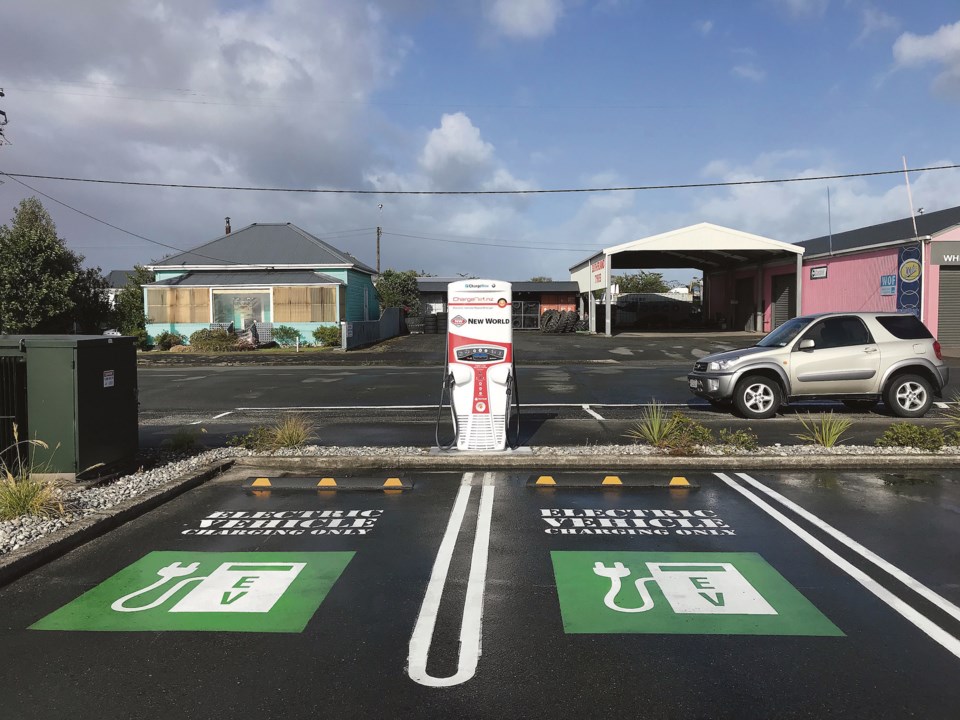WESTLOCK ‑ The Town of Westlock has its eye on future transportation needs and will use $140,000 in provincial grants that will cover 80 per cent of the costs for three electrical vehicle chargers.
While work will be done on the chargers this fall, residents can expect to wait about six to eight months for installation to be complete, making the spring 2023 the earliest that people can plug in. The electric vehicle (EV) charger has been on the town’s capital budget plan for a number of years and was deemed to be a priority by council after Westlock residents expressed a desire to see more electric vehicle chargers in their community.
At the Aug. 8 regular council meeting, councillors voted to amend the capital budget item DPC70-69 EV charger, to allow for additional electric vehicle chargers in town, expanding the scope from one Level 2 charger (at an original cost of $57,500 of which $31,625 was grant funding) to two Level 2 chargers and one Level 3 charger for a total cost of $193,000, which includes a contingency, $140,000 in grant funding, $51,433 from general operating reserve and $1,567 from corporate contribution.
As Canada moves toward meeting its climate goals, grants have been made available to communities via the Municipal Climate Change Action Centre, to install EV chargers to help meet the anticipated demands of an increased number of electric vehicles on the roads.
The Municipal Climate Change Action Centre was founded in 2009 as a collaborative initiative of Alberta Municipalities, Rural Municipalities of Alberta and the Government of Alberta. The MCCAC provides funding, technical assistance and education to help Alberta municipalities, school authorities and community related organizations advance actions that lower energy costs, reduce greenhouse gas emissions and improve climate resilience.
“Administration was successful in getting a larger grant than was originally expected — the original estimate, just over $31,000 in grant funding, that has come in at $140,000 with the change in scope,” said director of community services Gerry Murphy.
The electric vehicle chargers will be placed at different locations around town, including the Heritage Building which will have one Level 2 EV dual-port charger, the Aquatic Centre which will have the second Level 2 EV dual-port charger and the Rotary Spirit Centre which will have the Level 3 EV dual-port charger.
“It won’t adversely affect the five-year capital plan and (the reserve) will remain in a positive balance by the end of 2022, so this reserve can handle the additional numbers,” said director of finance Julia Seppola, noting there will be operating costs associated with the EV chargers. “I didn’t cost out the personnel that are going to be required to monitor and maintain, but I did talk with Mr. Murphy about who in his department will be looking after it.”
The operating costs of the units for the five-year extended warranty, network services and connectivity proposed in the project is $31,040 that will be broken down into each budget year in the amount of $6,208 per year plus energy costs, noted Seppola.
The costs, along with the energy costs, will be recovered through the amounts charged to users.
Revenue generated by the EV charges will cover energy costs, warranty, repairs, connectivity, and replacement of the units making it a user-pay system.
“The plan is to pass that onto the user and make this cost-neutral, other than the obvious investment that we’re going to make,” explained Seppola. “We do anticipate the lifespan of the EV chargers being anywhere from 10 to possibly 15 years depending on technology.”
The town is now taking steps to prepare for the upgrades and additional EV chargers, noted Seppola, to ensure connectivity and other requirements of the new infrastructure.
“The five-year warranty, the network servicing and connectivity are also included in here The connectivity is necessary because that’s how people get to it on their phone and get the payments through,” said Seppola, noting EV chargers would be based on a per hour charge rate. “We just have to make sure that we’re ready.”
EV stations
Level 1 chargers: A Level 1 charger is a regular 120-volt household plug that utilizes an adapter to charge an electric vehicle. Most PHEVs can be recharged overnight using a Level 1 charger. This is the slowest type of charger and can take nine to 12 hours to charge.
Level 2 chargers: A Level 2 charger uses a 240 volt plug to quickly charge an EV. These charging stations can fully charge an EV in five to 10 hours (or 30 to 90 km/h). This style of charger utilizes a standard connector (SAE J1772 plug) adopted by Canadian and American electric vehicle manufacturers for cross-compatibility. Level 2 charging stations plug into the same 240V outlet that a clothes dryer or oven would use and deliver more power than a Level 1 charger, charging an EV battery much faster.
Level 3 chargers: Level 3 chargers are the fastest charging option for EVs, making long-distance commutes easier. Using high voltages to charge the batteries, EVs can be topped up to 80 per cent battery life in as little as half an hour (or 1,600 km/h). This type of charger utilizes the CHAdeMO and SAE Combo CCS (combined charging system) plugs. Older EVs may not be designed to handle fast charging but fast-charging capabilities are becoming more common on newer models.



